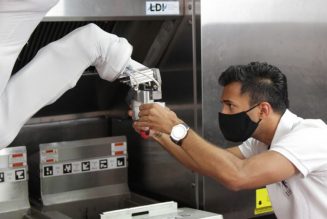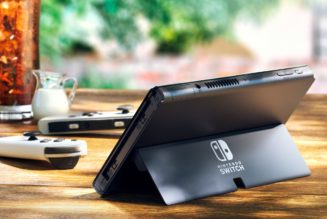An over-the-air update coming later this month will turn Samsung’s standalone SmartThings hubs into controllers for the new smart home standard Matter. The v2 hub will control Matter devices over Wi-Fi and ethernet, while the current hub and SmartThings dongle will also act as Thread border routers. Samsung is the first company to publicly announce Matter certification.
Jaeyeon Jung, Samsung Electronics corporate vice president and head of SmartThings’ mobile experience business, told The Verge in an interview that the company received its Matter certification early on Wednesday, October 12th, a week after Matter launched. Michelle Mindala-Freeman of the Connectivity Standards Alliance, which oversees Matter, confirmed that it started issuing certifications this week and said Samsung was among the very first to secure one.
“We worked with Silicon Labs to use software to simultaneously run Zigbee and Thread using the same hardware chipset.”
During the Samsung Developer Conference Keynote this week, Mark Benson, head of SmartThings, announced Matter support would be rolled out to its platform this month. Jung confirmed to The Verge following the keynote that Samsung plans to push over-the-air updates to all existing v2 and v3 SmartThings hubs, the SmartThings dongle, and the SmartThings app on Android. The software-based SmartThings hubs built into newer Samsung smart TVs, monitors, and Family Hub fridges will be upgraded to support Matter at a later date, says Jung.
While the upgraded hubs will still support Zigbee and Z-Wave, they won’t be Matter bridges, at least not anytime soon. “We don’t have a plan to support that function yet,” says Jung. “SmartThings users will be able to continue to use those devices connected to a SmartThings hub, but existing Zigbee and Z-Wave devices won’t be exposed to Matter.”
The good news is that SmartThings v3 hubs (now made by Aeotec) and the $35 dongle for Samsung appliances with SmartThings software hubs will become Thread border routers. “We worked with Silicon Labs to use software to simultaneously run Zigbee and Thread using the same hardware chipset,” says Jung. “Once we roll out the software, SmartThings v3 hubs will support both Zigbee and Matter over Thread devices, along with the dongle, too.”
This means if you have a compatible Samsung smart TV or smart fridge and you pick up the $35 dongle, you’ll have a SmartThings Matter controller with a Thread border router ready to go by the end of this month. Of course, there are no Matter devices available to control yet. But with the launch of the standard last week, we should see products start to roll out this year.
%2Fcdn.vox-cdn.com%2Fuploads%2Fchorus_asset%2Ffile%2F22506858%2Fmatter.png&w=2400&q=75)
a:hover]:text-black [&>a]:shadow-underline-gray-63 [&>a:hover]:shadow-underline-black text-gray-63″>Image: CSA
a:hover]:shadow-highlight-franklin [&>a]:shadow-underline-black dark:[&>a:hover]:shadow-highlight-franklin dark:[&>a]:shadow-underline-white md:text-30″>What is Matter?
Matter is a new smart home interoperability standard that provides a common language for smart home devices to communicate locally in your home, without relying on a cloud connection. It uses Wi-Fi and Thread wireless protocols and, at launch, will include smart sensors, smart lighting, smart plugs and switches, smart thermostats, connected locks, and media devices including TVs.
All this means that if a smart home device you buy has the Matter logo on it, you should be able to set it up and use it with any Matter-compatible device and in any Matter-compatible platform. Matter-compatible devices should start to become available toward the end of this year.
Amazon Alexa, Google Home, Samsung SmartThings, and Apple Home are some of the big smart home platforms signed on to support Matter, and we expect to see updates arriving on these platforms over the coming months.
While v2 hubs aren’t capable of being upgraded to Thread and will support Matter devices over Wi-Fi and ethernet, Jung says they will be able to control any Thread devices using a Thread border router built into another device. The same will be true of the software-based hubs in Samsung smart TVs, monitors, and Family Hub fridges, if you don’t add a dongle.
In addition to not exposing Zigbee or Z-Wave devices connected to the SmartThings hubs to Matter, Jung says Samsung has no plans to add its smart TVs or appliances to Matter as devices, meaning they will only be controllable through the SmartThings app and not other Matter controllers. TVs are in the first Matter spec, but appliances are not. (Samsung is a member of the Home Connectivity Alliance — an organization of major appliance manufacturers aiming to do for appliances what Matter is doing for the smart home, so someday you could control an LG washing machine in the SmartThings app and vice versa. The Verge saw a demo of this, but there’s no launch timing yet).
Jung says Samsung’s smart appliance ecosystem is one of the reasons the company thinks consumers will choose to use SmartThings over another platform now that Matter is making compatibility of devices less of an issue in the smart home. (SmartThings arguably built its brand on being the most open platform of the major players).
%2Fcdn.vox-cdn.com%2Fuploads%2Fchorus_asset%2Ffile%2F24106829%2FCES2021_FamilyHub_SmartThings_Cooking.png&w=2400&q=75)
She also pointed to the SmartThings Home Life services, a new feature in the SmartThings app that groups smart home functions into energy management, cooking, pet care, and air quality to provide actionable advice and control. Currently, these services only work with Samsung devices (except for energy management, which can monitor the energy use of all devices connected to SmartThings). But Jung says, with Matter, Samsung plans to support more devices in these services. “We seek to become an open platform so people can benefit from using SmartThings with all the smart devices they have in their home,” she says.
Samsung’s claim of pursuing platform openness rings just a little hollow
However, by not enabling the bridge function in its hubs, Samsung’s claim of pursuing platform openness with SmartThings rings just a little hollow. It’s the only platform of the big four that supports both Zigbee and Z-Wave devices, and many devices in the first Matter categories — lights, locks, sensors — use Zigbee and Z-Wave protocols. This meant Samsung had a unique opportunity it didn’t take. It could have been the first platform to bring Zigbee and Z-Wave devices into Matter, allowing all Matter-enabled platforms to control any compatible devices connected to its hub. Instead, SmartThings hubs and dongles will be the first way to get Zigbee, Z-Wave, and Matter all in the same ecosystem — but it will have to be SmartThings’ ecosystem.









